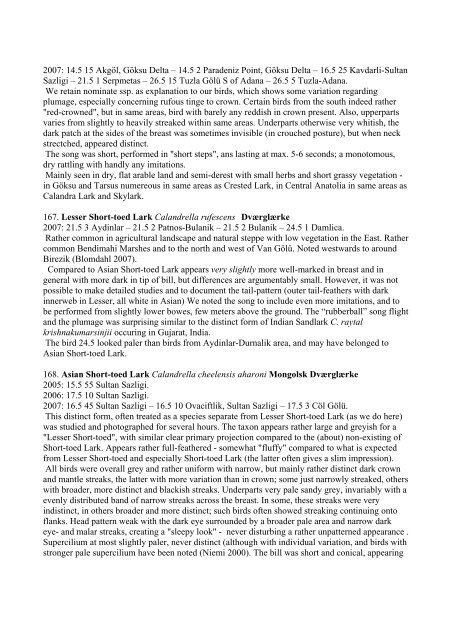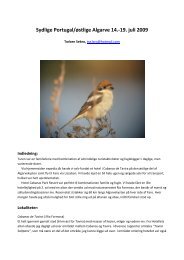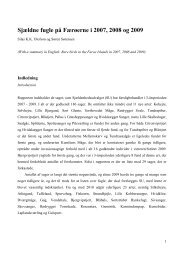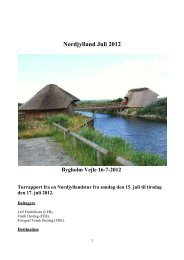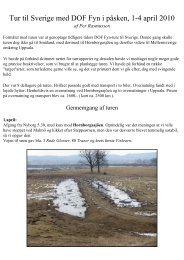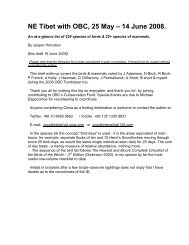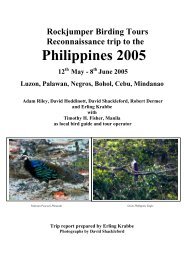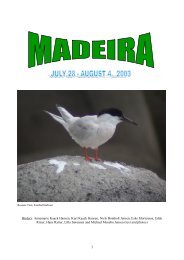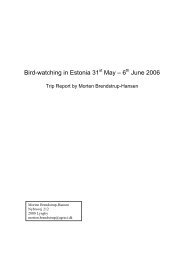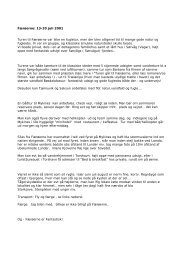TURKEY - a report from a birdwatching trip to Central ... - Netfugl.dk
TURKEY - a report from a birdwatching trip to Central ... - Netfugl.dk
TURKEY - a report from a birdwatching trip to Central ... - Netfugl.dk
Create successful ePaper yourself
Turn your PDF publications into a flip-book with our unique Google optimized e-Paper software.
2007: 14.5 15 Akgöl, Göksu Delta – 14.5 2 Paradeniz Point, Göksu Delta – 16.5 25 Kavdarli-Sultan<br />
Sazligi – 21.5 1 Serpmetas – 26.5 15 Tuzla Gölü S of Adana – 26.5 5 Tuzla-Adana.<br />
We retain nominate ssp. as explanation <strong>to</strong> our birds, which shows some variation regarding<br />
plumage, especially concerning rufous tinge <strong>to</strong> crown. Certain birds <strong>from</strong> the south indeed rather<br />
"red-crowned", but in same areas, bird with barely any reddish in crown present. Also, upperparts<br />
varies <strong>from</strong> slightly <strong>to</strong> heavily streaked within same areas. Underparts otherwise very whitish, the<br />
dark patch at the sides of the breast was sometimes invisible (in crouched posture), but when neck<br />
strectched, appeared distinct.<br />
The song was short, performed in "short steps", ans lasting at max. 5-6 seconds; a mono<strong>to</strong>mous,<br />
dry rattling with handly any imitations.<br />
Mainly seen in dry, flat arable land and semi-derest with small herbs and short grassy vegetation -<br />
in Göksu and Tarsus numereous in same areas as Crested Lark, in <strong>Central</strong> Ana<strong>to</strong>lia in same areas as<br />
Calandra Lark and Skylark.<br />
167. Lesser Short-<strong>to</strong>ed Lark Calandrella rufescens Dværglærke<br />
2007: 21.5 3 Aydinlar – 21.5 2 Patnos-Bulanik – 21.5 2 Bulanik – 24.5 1 Damlica.<br />
Rather common in agricultural landscape and natural steppe with low vegetation in the East. Rather<br />
common Bendimahi Marshes and <strong>to</strong> the north and west of Van Gölü. Noted westwards <strong>to</strong> around<br />
Birezik (Blomdahl 2007).<br />
Compared <strong>to</strong> Asian Short-<strong>to</strong>ed Lark appears very slightly more well-marked in breast and in<br />
general with more dark in tip of bill, but differences are argumentably small. However, it was not<br />
possible <strong>to</strong> make detailed studies and <strong>to</strong> document the tail-pattern (outer tail-feathers with dark<br />
innerweb in Lesser, all white in Asian) We noted the song <strong>to</strong> include even more imitations, and <strong>to</strong><br />
be performed <strong>from</strong> slightly lower bowes, few meters above the ground. The “rubberball” song flight<br />
and the plumage was surprising similar <strong>to</strong> the distinct form of Indian Sandlark C. raytal<br />
krishnakumarsinjii occuring in Gujarat, India.<br />
The bird 24.5 looked paler than birds <strong>from</strong> Aydinlar-Durnalik area, and may have belonged <strong>to</strong><br />
Asian Short-<strong>to</strong>ed Lark.<br />
168. Asian Short-<strong>to</strong>ed Lark Calandrella cheelensis aharoni Mongolsk Dværglærke<br />
2005: 15.5 55 Sultan Sazligi.<br />
2006: 17.5 10 Sultan Sazligi.<br />
2007: 16.5 45 Sultan Sazligi – 16.5 10 Ovaciftlik, Sultan Sazligi – 17.5 3 Cöl Gölü.<br />
This distinct form, often treated as a species separate <strong>from</strong> Lesser Short-<strong>to</strong>ed Lark (as we do here)<br />
was studied and pho<strong>to</strong>graphed for several hours. The taxon appears rather large and greyish for a<br />
"Lesser Short-<strong>to</strong>ed", with similar clear primary projection compared <strong>to</strong> the (about) non-existing of<br />
Short-<strong>to</strong>ed Lark. Appears rather full-feathered - somewhat "fluffy" compared <strong>to</strong> what is expected<br />
<strong>from</strong> Lesser Short-<strong>to</strong>ed and especially Short-<strong>to</strong>ed Lark (the latter often gives a slim impression).<br />
All birds were overall grey and rather uniform with narrow, but mainly rather distinct dark crown<br />
and mantle streaks, the latter with more variation than in crown; some just narrowly streaked, others<br />
with broader, more distinct and blackish streaks. Underparts very pale sandy grey, invariably with a<br />
evenly distributed band of narrow streaks across the breast. In some, these streaks were very<br />
indistinct, in others broader and more distinct; such birds often showed streaking continuing on<strong>to</strong><br />
flanks. Head pattern weak with the dark eye surrounded by a broader pale area and narrow dark<br />
eye- and malar streaks, creating a "sleepy look" - never disturbing a rather unpatterned appearance .<br />
Supercilium at most slightly paler, never distinct (although with individual variation, and birds with<br />
stronger pale supercilium have been noted (Niemi 2000). The bill was short and conical, appearing


